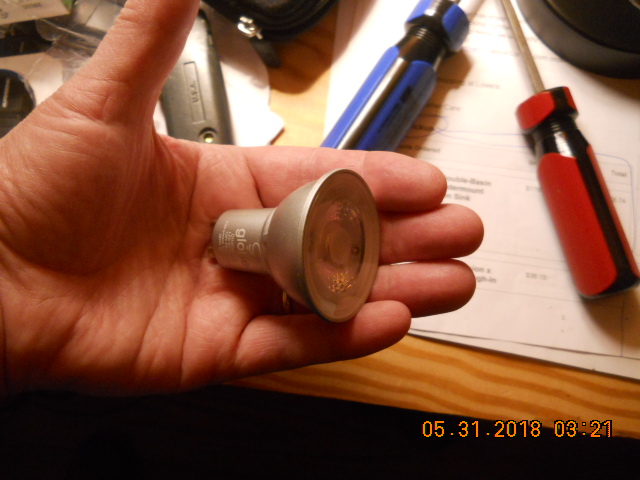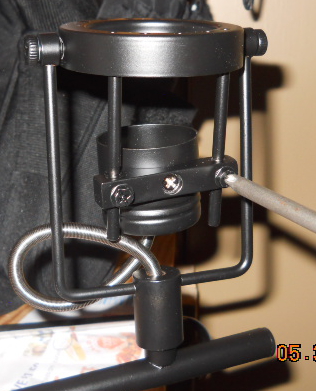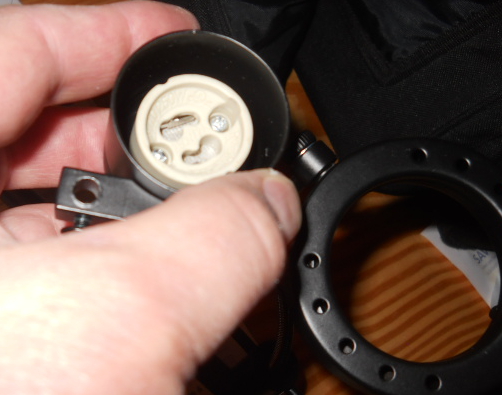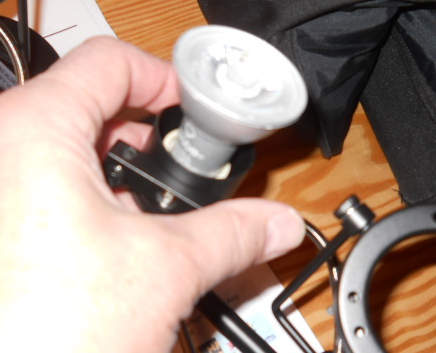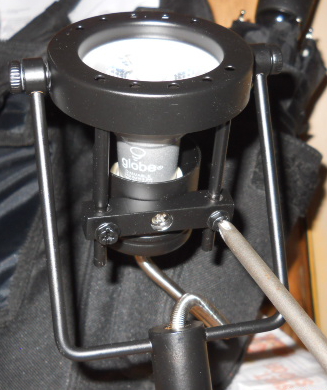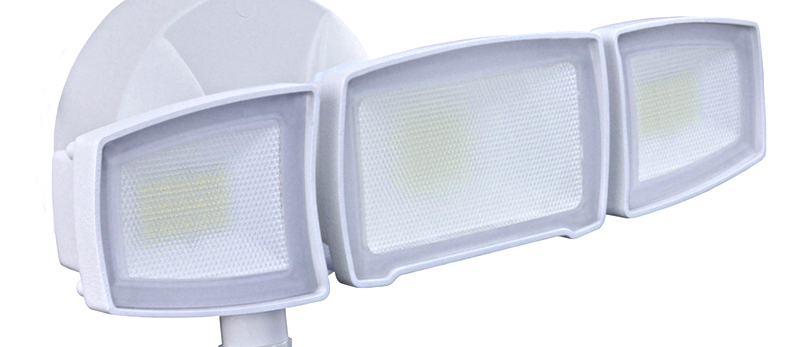LED Lighting: what you should know is about this Architect’s approach to LED lighting. This Architect believes it only makes sense to use fixtures that allow Clients to replace the lamps (“bulbs”).
Photo taken of new LED light fixture WITH replaceable LED lamps, as selected by HA Senior Staff Architect for his own new house, now under construction.
While the above statement probably sounds obvious to most people, there’s a huge war going on right now in the lighting industry. A war being waged against the consumer.
And most likely 99.9% of consumers don’t even know it, especially when they’re standing in the lighting aisle of a Lowes or Home Depot, selecting light fixtures for their house.
What are we talking about?
LED “INTEGRAL” lamps (bulbs) versus REPLACEABLE LED LAMPS.
Whether you know it or not, there are many LED light fixtures these days that are using “Integral” LED lamps (bulbs). And they are often accompanied by hype comments online and on the box that says/reads: ” NEVER HAVE TO REPLACE BULBS”. That’s bound to confuse people, and it should. What this scam means: “YOU CANNOT CHANGE THE BULBS, BECAUSE THEY ARE BUILT-INTO AND ARE A FIXED PART OF THE LIGHT FIXTURE, WHICH MEANS: WHEN ANY LAMP (bulb) BURNS OUT (and it will, eventually), YOU’RE GOING TO HAVE TO PAY YOUR ELECTRICIAN OVER $200 TO REPLACE THE ENTIRE FIXTURE.”
Do you understand that? It means that many, if not most newer LED light fixtures don’t allow you to change out the bulbs (lamps). Rather, the LED lamp part that generates the light CANNOT ever be removed (as in unscrewed). The entire light fixture will have to be trashed. And unless you enjoy taking your life in your hands to remove an entire light fixture., including detaching the wiring, then replacing it with a brand new light fixture, you’re likely going to want to pay a licensed Electrician to do that for you. And they probably are going to charge you a minimum of $75 just to appear on your doorstep.
continued below:
Then another $100 to $125 to replace the light fixture, however it could be more, if you don’t have a replacement light fixture and your Electrician has to first diagnose what has happened, then have to go somewhere to buy a new light fixture, then return for a 2nd trip to your house, then replace the fixture. Okay, so that’s 2 trips at perhaps $75 each, the time and mileage to buy a new fixture, then replace it. Probably at least $200 and it could be double that, by the time they’re done.
Are you starting to understand how silly the entire idea of “integrating” LED lamps into a light fixture, essentially, making it impossible to change the bulbs when they one day burn out? Some folks will probably call that “stupid engineering.” Purposely designing light fixtures so that you have to replace the entire fixture rather than just replacing a burned out lamp (bulb).
If we didn’t know better, this concept sounds like collusion between some Electricians and some light fixture manufacturers: guaranteeing that both businesses will reap huge incomes due to fixtures burning out in the future, because consumers can’t simply unscrew the old bulb and screw in a new one, for much less than the cost of the new entire light fixture (especially when you include the cost of the Electrician).
And we’re going to bet that No One reading this online article was aware of this new practice in the engineering and sale of LED light fixtures until you read this article. It was news to us as well. And it both shocked and angered us. What a silly way to design a light fixture!
continued below:
Our firm actually had a conversation with a manufacturer of these so-called “integrated LED fixtures.” Their main reason for making them is because they “look cool.” Now don’t get us wrong: we’re all about attractive design. We’ve won 10 architectural design awards in the last 3 years. However, when attractive design gets in the way of functional replacement, we’re going to always go with FUNCTION. It is a downright STUPID idea to make light fixtures that CAN’T have their lamps (bulbs) change when they burn out, forcing you to change then entire fixture.
And while we love LEDs, because they consume less energy and do last longer that any other mass-market lamp on the market today, THEY DO NOT LAST FOREVER. And in our personal experience, they don’t last anywhere near the claimed 22,000 hours of operation. During the last 7 years, we have replaced at least 3 or 4 LED A19 lamps in one house and we installed them ourselves. Those fixtures probably burn for let’s say 3 hours a day x 365 days x 7 years = 7,665 hours. In other words, that is a good long time, but nowhere near the manufacturer claims, and I’ll bet that 100% of people not being able to simply change out a bulb, even after 7 years would be very angry to discover that they had so-called “integrated” LEDs and could not change the burned out lamps and had to not only buy a new entire fixture, but also pay an Electrician to replace it! We certainly would be. But we didn’t make that mistake. Nor are we with our latest projects, including the house for our Senior Staff Architect.
continued below:
But this took some long and hard searching on the Internet to find NON-integrated LED light fixtures, including for track lights. In the case of track lights, it was pretty near impossible. We succeeded. But it felt like we were searching for a needle in a haystack. There’s a key to this:
YOU HAVE TO KNOW WHAT SIZE, SHAPE AND TYPE OF LED LAMP (bulb) YOU NEED & WANT TO REPLACE IN WHAT FIXTURE TYPE.
In our case, we decided on the GU10 M16 lamps for our track lights. The GU10 refers to the 10 mm spacing between the electrical pins at the power end of the lamp. The MR16 refers to the general shape and size, which is compact. It is NOT low voltage and we recommend you stick with “line voltage” type lamps, so you don’t need any special transformers on your job to convert line voltage (120v) down to 12v or other lesser power. Here’s the GU10 MR16 lamps that came with the Global 3-lamp track lights we purchased for our new house project (120v):
This illustrates something not many people understand: LED lamps (bulbs) come in many of the same sizes as ordinary bulbs (lamps). There’s the medium Edison screw-in base (A19 ), which is what the old incandescent bulbs have been and there is an LED that looks about the same and is the same size, but is an LED. The GU10 LED pictured above is based on the old Halogen MR16 with 10mm distance between its screw-in legs. Below, you can see the screw-in posts:
This LED will typically fit into any light fixture that the old MR16 GU10 halogen will (unless there’s something unusual about the halogen fixture, like an odd depth). The best GU10 fixture has a variable depth arrangement that lets you adjust the depth of the space for the lamp.
This is the lamp used in the new gimbal-ring track lights, selected for their industrial style. However, the most important thing here is this: LED LAMPS (bulbs) COME IN MANY SIZES AND SHAPES, MATCHING PREVIOUS LAMPS, like Par20, Par30, A19, GU10 and others.
This information should lead you to search for fixtures with the lamp size and type, so you can be assured that you can change-out the lamps after they burn out. If you simply look for LED fixtures, most of what you find may be Integral LEDs, which to us, has become a dirty word. You want to be able to replace burned out lamps with new ones. And LEDs are the logical choice, because they use only a fraction of the wattage of incandescent and even CFLs.
In the photo above, most people might even think that’s an MR16 Halogen lamp. No, it’s not. It’s an LED. And while it generates 50w equivalent of light (520 Lumens), it only consumes 6.5 watts of power. And with 3 lamps on each track light, that’s over 1,500 Lumens (over 150w equivalent incandescent of light). It is also EnergyStar rated. The manufacturer (Global) claims 22.8 years of life, based on 3 hours of use per day. We hope that happens. But if the approximately 6 to 7 years we’ve experienced in the past with LEDs happens, we’re okay with removing the burned out lamps and replacing them with new ones.
Why all the fuss about LEDs and why not just use the A19 Edison screw-in base type that will fit into any incandescent fixture. You can! Go right ahead, if you’d like to do so. However, the new compact light fixtures that use lamps like the GU10 do have a more striking appearance and tend to be a bit less obtrusive.
Now then, some people can be intimidated by how to changeout a GU10 lamp (LED or halogen). We were able to figure this out in about 5 minutes with the new Global gimbal ring fixtures:
Here’s the empty gimbal ring:
Now you take a Phillips Head screwdriver and loosen the screws holding the lampholder part of the fixture to the yoke:
It unfortunately is not as easy as simply screwing in the lamp like with an Edison A19 lamp. But it’s not the end of the world, either. You loosen those 2 screws and slide the lampholder down and off the 2 legs, then you can hold the free lampholder in your hand:
See the 2 holes made for the 2 posts from the MR16 lamp?
You insert the G10-MR16 LED lamp into those, then rotate it until it stops, which is only about a 1/4 turn:
Now you slide the lampholder back onto the 2 legs. You are installing the lamp into the fixture from rear of the fixture. That’s how this fixture is intended to work:
You slide the lampholder up until it hits the detent ring inside the gimbal ring:
Then you tighten the screws you loosened in the first place to secure it into place. Then you can loosen the screws on the yoke a little to allow you to swivel the light in various directions, and rotate the base to move the light around.
To summarize: yes, the new LED compact fixtures look great. Just be sure you’re getting a replacement type of fixture, not the “integral” LED type.
Here’s a type of “integral” LED fixture type:
Not all are as tell-tale as this one, which is recognizable by its rectangular with rounded-corners image:
Each of the above integral LED lamps is totally customized by the fixture manufacturer. Most like this are fixed and permanent and cannot be replaced. The entire fixture must be replaced, if you want to replace any of the burned-out lamps. There are other integral LED track lights and other fixture types not so recognizable as this one. Read the specifications carefully. If you’re in a store, ask a salesperson to show you how to change out the lamps. If they can’t figure it out, chances are you can’t and it is integral. Recommend not buying that type.
tag: LED lighting, post and beam, timber frame, Cashiers, Highlands, Lake Toxaway, Sapphire, Glenville, Sevierville, Tahoe, Aspen, Hendersonville, Asheville


